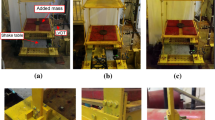Abstract
A novel distributed tuned liquid damper (DTLD) for reducing vibration in structures is proposed in this paper. The basic working principle of the DTLDs is to fill the empty space inside the pipes or boxes of cast-in-situ hollow reinforced concrete (RC) floor slabs with water or other liquid. The pipes or boxes then work as a series of small TLDs inside the structure, to increase the damping ratio of the entire structural system. Numerical simulation that accounts for the fluidstructure coupling effect is carried out to evaluate the vibration-reduction efficiency of the DTLDs. The results show that the DTLDs are able to considerably increase the damping of the structure and thus reduce its vibration. An additional benefit is that the DTLDs do not require architectural space to be added to the structure.
Similar content being viewed by others
References
Cai DY, Li AQ and Cheng WR (1998), “Study on Equivalent Mechanical Model of Tuned Liquid Damper,” Earthquake Engineering and Engineering Vibration, 18(1): 80–87. (in Chinese)
CECS 175 (2004), Technical Specification for Castinsitu Concrete Hollow Floor System, Beijing. (in Chinese).
Gohner U and Mauch H (1998), “FLOTRAN: Numerical Method and Industrial, Applications,” International Journal of Computer Applications in Technology, 11(3–5): 199–202.
Haque JN, Mahmud T, Roberts KJ and Rhodes D (2006), “Modeling Turbulent Flows with Free-surface in Unbaffled Agitated Vessels,” Industrial & Engineering Chemistry Research, 45(8): 2881–2891.
Hirt CW and Nichols BD (1981), “Volume of Fluid (VOF) Method for the Dynamics of Free Boundaries,” Journal of Computational Physics, 39: 201–225.
Housner GW (1957), “Dynamic Pressure on Accelerated Fluid Containers,” Bulletin of Seismic Society of America, 47(1):15–35.
Jia Y and Li HN (1998), “Simulation of Dynamic Liquid Pressure for Tuned Liquid Damper,” Earthquake Engineering and Engineering Vibration, 18(3): 82–87.
Jia Y, Li HN and Li YC (2000) “An Actual Computing Example for a Tall Structure Using TLD to Reduce Vibration,” Earthquake Engineering and Engineering Vibration, 20(2): 135–140. (in Chinese)
Jia Y, Li HN and Song YS (2002) “Simplied Algorithm of Tuned Liquid Damper for Seismic Response of Fixed Offshore Platform,” Earthquake Engineering and Engineering Vibration, 23(3): 160–164. (in Chinese)
Jia Y, Zhao L and Yu F (2006), “Effect of Different Parameters on TLD Vibration Control,” Earthquake Engineering and Engineering Vibration, 26(4): 226–230. (in Chinese)
Li HN, Jia Y, Li XG et al. (2000), “Study on Vibration Control Using TLDs for Multi-mode Reponse of tall Flexible Structures,” Earthquake Engineering and Engineering Vibration, 20(2): 122–128. (in Chinese)
Li HN et al. (2005), Structure Vibration and Control, Beijing: China Architectural and Industrial Press. (in Chinese)
Lu XZ et al. (2005) “Fluid-solid Interaction Simulation on Wind Vibration of CFRP Cable,” Proceedings of the 12 th National Conference of Wind Engineering, Xi’an: 69–75. (in Chinese)
Qian JR, Warnitchai P and Ding X (1998), “Shaking Table Experiment Study on the Suppression Dynamic Response of a TV Tower with TLD,” Journal of Building Structures, 16(5): 31–39. (in Chinese)
Wu Y and Shen SZ (2003), “Numerical Wind Tunnel Method for Wind-vibration of Membrane Structures,” Space Structure, 9(2): 38–43. (in Chinese)
Xu YL and Feng DB (2005), “Development of the Castin-situ Hollow Floor and Energy-saving RC Structures,” Proceedings of the National Conference on Cast-in-situ Hollow Floor Structure, Shanghai: 1–7. (in Chinese)
Yue BZ, Liu YZ and Wang ZL (2000), “Study on Simulation and Dynamic Characters of the Nonlinear Coupling Between TLD and Structures,” Journal of Vibration and Shock, 19(4): 1–4. (in Chinese)
Zheng Z, Chen F and Hou Z (2003), “Fluid-structure Interaction During Large Amplitude Sloshing and TLD Vbration Control,” Tsinghua Science and Technology, 8(1): 90–96. (in Chinese)
Author information
Authors and Affiliations
Corresponding author
Additional information
Supported by: Cultivation Fund of the Key Grant Scientific and Technical Innovation Project, Ministry of Education of China Under Grant No.704003
Rights and permissions
About this article
Cite this article
Ye, L., Lu, X., Qu, Z. et al. Distributed TLDs in RC floors and their vibration reduction efficiency. Earthq. Eng. Eng. Vib. 7, 107–112 (2008). https://doi.org/10.1007/s11803-008-0751-9
Received:
Accepted:
Published:
Issue Date:
DOI: https://doi.org/10.1007/s11803-008-0751-9




